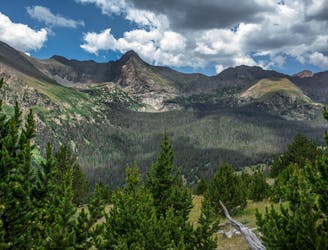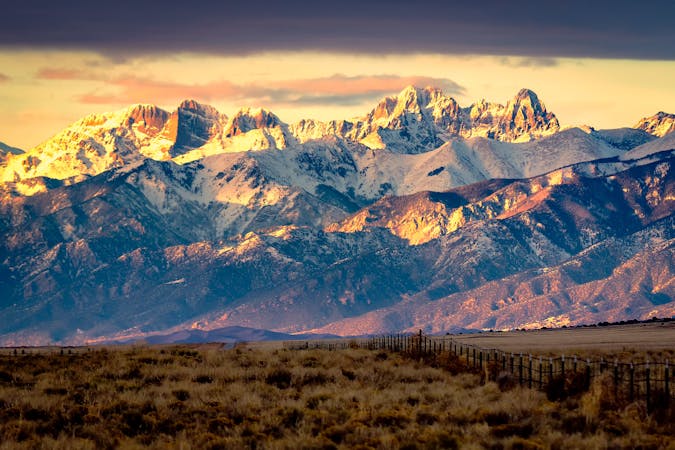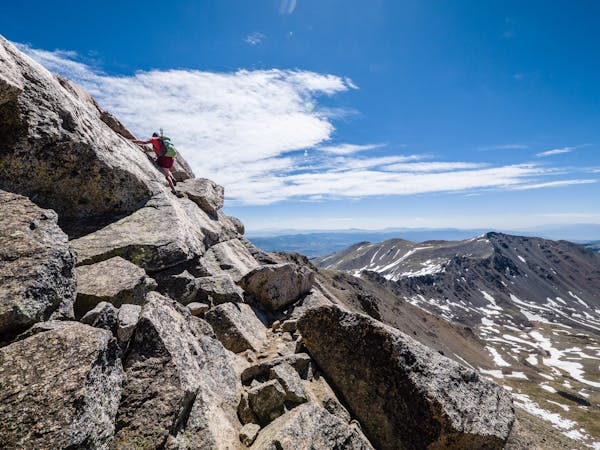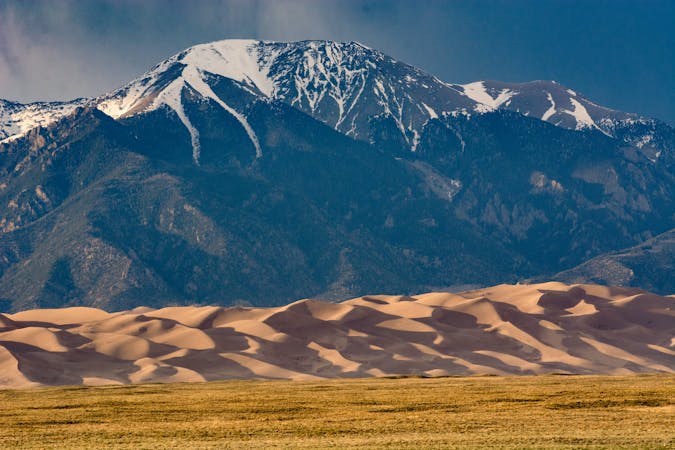104 m away
Humboldt Peak

One of the least technical peaks in the Sangres.
Severe Hiking
- Distance
- 20 km
- Ascent
- 1.3 km
- Descent
- 1.3 km

From South Colony Lakes TH. Class 3 or 4. 4,400'/12mi from Upper TH, 5,550'/18mi from Lower TH.
Hiking Severe

Imported from 14ers.com. Offline photos and route available from the 14ers app.
Trailhead:
Take Colorado 69 south from Westcliffe. Drive 4.5 miles and turn right on Colfax Lane. Drive 5.5 miles to the end of Colfax. Turn right and drive 1 mile on a dirt road to a junction. Continue straight up the 120 Road for 0.3 mile to the Lower 2WD Trailhead at 8,800'. To reach the Upper 4WD Trailhead, continue 2.7 miles to parking/camp spots before the first river crossing, near 9,950'. In 2009, the South Colony Lakes road was permanently closed here (gate) and this is the current trailhead. The trail starts next to the trailhead kiosk, in the parking area.
Route:
From the gate closure at 9,900', cross the foot bridge and walk 2.5 miles up the South Colony Lakes (Approach) road to reach a junction - 1. Turn left, cross the river on a log bridge and reach what used to be the 4WD trailhead, before they closed the upper road. Continue past the gate ( 2) and walk 3/4 mile to 11,400' where the old road ends and smaller trail begins. Hike through the bushes and into the trees - 3. Follow the trail as it turns left above 11,600' and parallels the stream below the lower South Colony Lake. Near 11,650' and before the lake, turn left on the trail towards Broken Hand Pass - 4. From here it's just under 2 miles to the summit of the Needle. The trail is defined for a while but can become hard to follow as you get higher into the rocky terrain - 5. Follow the trail/cairns south up the north slopes of Broken Hand Peak before traversing west to reach loose terrain below Broken Hand Pass - 6. Climb through a narrow, Class 3 section with few options ( 7) and hike another 200 feet to reach the pass at 12,850'.
Taken from a short distance to the east of the pass, 8 is a view of the remaining route up the south face. Turn right and follow a defined trail toward the Needle's upper south face. Your goal is to traverse into a large gully, climb a few hundred feet, cross west over a rib, and ascend a second gully to the summit ridge. I'll try to make it as simple as possible by naming the two gullies "east" and "west." The east gully does go to the summit (see variation, below) but if you want to keep the difficulty at Class 3, switch to the west gully during the ascent. First, you need to get to the east gully... Continue on the trail toward the south face - 9 and 10. Near 13,300', down-climb a short pitch into a notch ( 11) then turn left and descend approximately 75 feet to reach the east gully - 12 and 13. STOP! The trail ends here and it's important to look carefully at the area so you know where to return to the trail on your descent. The remainder of the route to the summit consists of Class 3 scrambling, sometimes with high exposure.
Climb approximately 300 feet in the east gully ( 14 and 15) to reach a section where the center of the gully becomes deep and narrow. Above this area, the gully forms a dihedral and this is the place to begin your crossover to the west gully. Just below the dihedral, look for a spot to turn left and cross the center of the gully - 16, 17 and 18. Next, climb a steep pitch to reach a notch to the right of an angled rock tower - 19 and 20. The moves across the gully and to the notch are difficult Class 3 and the crux of the route. Now on the rib which separates the two gullies, climb slightly higher ( 21) and scramble down a few feet into the west gully - 22. STOP! Look carefully at this area so you know where to cross back to the east gully later. The west gully is fairly straightforward and leads to the summit ridge. Climb steep, stable rock ( 23, 24 and 25) for nearly 400 feet to the top of the gully, near 14,000'. Continuing in the same direction, scramble up a few more steep sections ( 26 and 27), to reach the summit ridge - 28. Scramble along a narrow section and turn left to reach the summit - 29.
CLASS 4 VARIATION - Climbing the entire east gully: This variation follows the entire east gully to the summit ridge. It's more difficult than the crossover route described above but provides a more direct climb. From the base of the dihedral, continue climbing just right of it - 30. After a short, steep pitch, re-enter the gully and continue climbing in its confines- 31 and 32. Continue up the obvious gully to 13,900' where it opens up a few hundred feet below the summit - 33. Stay on the east (right) side, next to a wall, and follow the remaining gully to the summit ridge - 34 and 35. Turn left and scramble to the top.
Notes:
This climb involves a lot of Class 3 rock climbing and careful route finding. IMPORTANT: This route enters the Sangre De Cristo Wilderness area. Wilderness areas have special regulations and restrictions for party size, dispersed camping, campfires, etc. Also, dog owners should read the wilderness information carefully because some wilderness areas prohibit dogs to be off-leash and/or limit how close dogs can be to lakes and streams. If you have questions about the wilderness area, please contact a U.S. Forest Service office for the National Forest(s) listed above.
Severe
Hiking challenging trails where simple scrambling, with the occasional use of the hands, is a distinct possibility. The trails are often filled with all manner of obstacles both small and large, and the hills are very steep. Obstacles and challenges are often unexpected and can be unpredictable.
104 m away

One of the least technical peaks in the Sangres.
Severe Hiking
6 km away

Two seldom-seen alpine lakes, high in the Sangre de Cristo Wilderness.
Difficult Hiking
6 km away

Alpine hike to a Sangre de Cristo 13er, within Great Sand Dunes National Park and Preserve.
Extreme Hiking

10 routes · Alpine Climbing · Hiking

46 routes · Alpine Climbing · Hiking

7 routes · Alpine Climbing · Hiking